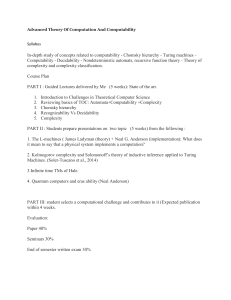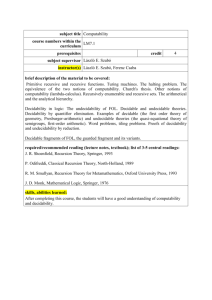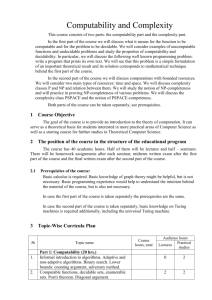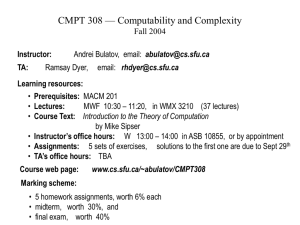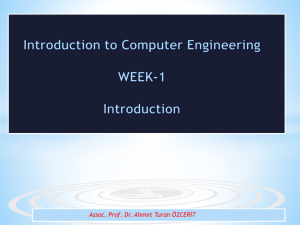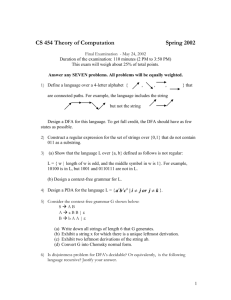5 - Duke University
advertisement
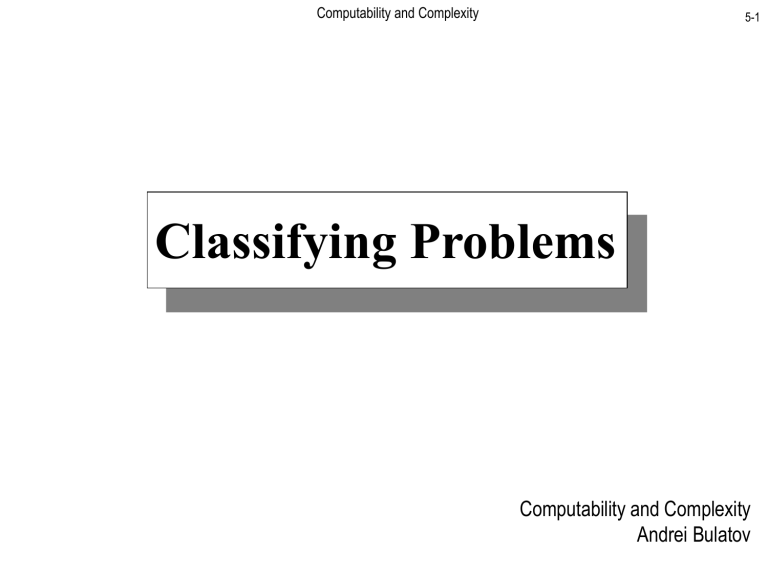
Computability and Complexity
5-1
Classifying Problems
Computability and Complexity
Andrei Bulatov
Computability and Complexity
Problems and Languages
We have seen that every decision problem has an associated
language L(,e) (via a suitable encoding e)
Hence, to classify decision problems we will develop methods to
classify languages
5-2
Computability and Complexity
Decidable Languages
Definition A language L is decidableª if there exists a TM T, with
2 final states q A and qR , such that
• If x L then T(x) halts in state q A
• If x L then T(x) halts in state qR
ªalso known as recursive
T is said to decide the language L — it gives a yes or no answer
for each possible string from *
5-3
Computability and Complexity
Examples
The following languages are decidable:
• *
•
• {x| |x| = 20}
• {x | x is prime}
• {x | x encodes a graph G, and a Hamilton circuit of G}
• {x | x is a valid encoding of a TM}
5-4
Computability and Complexity
5-5
Examples
All languages accepted by finite automata, or generated by
context-free grammars are decidable
Decidable
Languages
Regular
Languages
All
Languages
Context-free
Languages
(for finite automata see Discrete Mathematics course or Sipser)
(for context-free grammars see Compilers course or Sipser)
Computability and Complexity
Acceptable Languages
Definition A language L is acceptableª if there exists a TM T, with
2 final states q A and qR , such that
• If x L then T(x) halts in state q A
• If x L then T(x) halts in state qR or infinite
ªalso known as Turing-acceptable or Turing-recognizable
T is said to accept the language L — it gives a yes answer for each
string in L, in all other cases it gives a no answer or fails to halt
5-6
Computability and Complexity
Acceptable vs. Decidable
• If a language is decidable, then it is acceptable.
• If a language, L, is acceptable, and its complement L is also
acceptable, the it is decidable.
(Proof: run the two acceptor machines alternately until one halts)
So, to show that there are languages that are not decidable, we must
find a language that is not acceptable …
5-7
Computability and Complexity
The Halting Problem
Halting
Instance: A Turing Machine T and an input string x.
Question: Does T(x) halt?
Once we choose an encoding for Turing machines, the corresponding
language is:
LHalting {" T ; x" | T ( x ) terminates}
• LHalting is acceptable
- use a universal TM U to simulate T on x and modify it so that
that if it halts then it moves to “Accept” state
• LHalting is not decidable
- see next slide
5-8
Computability and Complexity
• Assume, for contradiction, that there is a TM TH that decides
LHalting
• Construct a new T from TH so that for input x, T simulates
TH ( x; x ) but
- if TH accepts “x;x” then T goes into an infinite loop,
- if TH rejects “x;x” then T accepts x.
5-9
Computability and Complexity
5-10
I N P U T
A?
R?
T
Computability and Complexity
5-11
I N P U T
A?
R?
I N P U T ; I N P U T
T
A?
R?
TH
Computability and Complexity
• Consider the computation T(T)
- if T(T) halts this implies that TH rejects “T;T”,
implying that T(T) does not halt!
- if T(T) does not halt this implies that TH accepts “T;T”,
implying that T(T) halts!
• Hence TH cannot exist, so LHalting is undecidable.
5-12
Computability and Complexity
Consequences
• The language LHalting is not acceptable.
• There is no Turing machine that can give correct answers to the
Halting problem on all inputs.
• Hence, by Turing’s Thesis:
The Halting problem cannot be solved by any algorithm!
This result was first announced in Turing’s 1936 paper
5-13
Computability and Complexity
Reducibility
A major tool in analysing and classifying problems is the idea of
“reducing one problem to another”
Informally, a problem is reducible to a problem if we can
somehow use methods that solve in order to solve
5-14
Computability and Complexity
Many-One Reducibility
Definition A language A is many-one reducible (or m-reducible, or
mapping reducible) to a language B if there exists a total and
computable function f such that for all x *
x A f (x) B
• We denote this by writing A m B
• We can use a machine that decides B (plus a machine that reduces A)
• So, in a sense, A is “no harder than” B
5-15
Computability and Complexity
Properties of Many-One Reducibility
• If L1 m L2 and L2 is decidable, then so is L1
(Just build a machine that computes f(x) and then behaves like
the machine that decides L2 )
• m is reflexive and transitive
• If L2 is any language (apart from and *) and L1 is
decidable, then L1 m L2
The first property can be used when trying to prove that a language
is decidable (or undecidable).
The last property implies that many-one reducibility is too weak to
distinguish between decidable languages — they are pretty much
All reducible to each other!
5-16
Computability and Complexity
Other Undecidable Problems
ACCEPTANCE
Instance: A Turing Machine (acceptor) T and an input string x.
Question: Does T accept x?
The corresponding language is:
Theorem
LAccept
Proof
see next slide
LAccept {" T ; x" | T accepts x}
is undecidable.
5-17
Computability and Complexity
We show that LHalting m LAccept
For every input “T;x” of LHalting , we do:
• Add to T two new states q A and qR (to guarantee that they
are not in T already we may need to rename the states of T)
• Change the transition function by adding transition from every
final state to q A
• Denote the obtained machine T’
Note that T’ accepts x if and only if T halts on x
Therefore, the function f : * * which maps “T;x” to “T’;x”
is computable and provides a mapping reduction from LHalting
to LAccept
5-18
Computability and Complexity
Regularity
Instance: A Turing Machine T.
Question: Can T be simulated by a finite automaton?
Ambiguous Grammars
Instance: A context-free grammar G.
Question: Is G ambiguous?
5-19
Computability and Complexity
Diophantine Equations
Instance: A multivariate polynomial equation such as
x 2 y 3xy y 2 17 0
Question: Does this equation have an integer-valued solution?
See “Hilbert’s Tenth Problem is Unsolvable”
M.Davis, American Mathematical Monthly 80 (1973) pp.233-269
5-20
